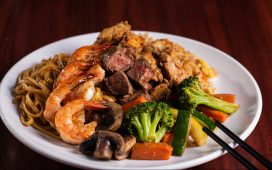Table Of Contents
Longaniza is a sausage, fresh or cured, of Spanish origin that is allegedly thousands of years old. It’s created by stuffing pig intestines with a mixture of cinnamon (or nutmeg), garlic, paprika, anise and vinegar. Eventually it made its way into surrounding territories and now everyone has their own variation of this unique dish.
Below we will take you on a wild ride explaining the different types of longaniza, some optimal food pairings, and where you can find longaniza today.
Different Types of Longaniza
We will attempt to define the main qualities of each region’s longaniza but just know, this is a dynamic dish. You’ll find that each style has many interpretations and our guide isn’t the end-all-be-all, it’s just a rough baseline.
Spanish Longaniza
Being the original, Spanish Longaniza is the standard that other countries work from. While most countries use pepper as the boldest spice, Spanish varieties use paprika to contribute a slightly sweet, slightly spicy tang to the sausage. Garlic and onion are also common flavors (which isn’t surprising coming from Spain).
Additionally, Spanish Longaniza is typically cured before it is eaten raw or cooked. The curing process can last days to weeks and will give the sausage a harder texture and deeper flavor.
Just like chorizo, longaniza is an incredible addition to the hearty breakfast foods like bacon, eggs and toast. It also goes well with just about any of the common Mexican dishes like tacos, burritos, nachos and enchiladas.
Filipino Longaniza
It might have started in Spain, but the Phillipines took longaniza to whole new heights. It’s impossible to characterize how Filipinos cook this dish because there are at least a dozen Filipino variations.
The most noticeable change to the recipe is the use of alternative meats like chicken, tuna and beef. They also have a few dry variations that cure for a little longer and create more of a leathery texture.
Chilean Longaniza
Longaniza is one of the most commonly eaten foods available in Chile. Well known for it’s potito sandwich, Chile incorporated this delicious sausage into a sandwich whose base ingredient is beef rectum. While it may not sound all that appealing, this dish is delectable and a staple in any traditional chilean household.
The ingredients don’t seem to stray too far from the Spanish variant, but Chileans tend to put Longaniza more commonly in stews and sandwiches.
Argentinian Longaniza
Similar to the Chilean variant, Argentinian longaniza is a mainstay in many of their dishes. They tend to use beef more often than pork and carry a distinct red wine flavor
One thing that makes Argentinian longaniza unique is that they fry it before eating. This gives it a crispy outer shell that juxtaposes the soft, juicy interior. It’s a common appetizer or snack in bars and is a great way to start your meal.
Puerto Rican Longaniza
While pork is the primary meat used in most countries, Puerto Rico uses chicken or turkey. As we stated before, there are many variations of this dish and so the spices and ingredients used can vary greatly.
One unique thing about Puerto Rican longaniza is that they add achiote oil to the mix. Achiote is a reddish seed that is ground into a powder and has a slightly bitter, peppery taste. The oil is also used as a coloring agent.
Puerto Rican longaniza is often cooked with rice and beans as a main dish or served as part of a tapas meal.
Mexican Longaniza
Mexican longaniza is one of the most popular types of longaniza. It comes in a few different varieties: fresh, dry and smoked.
The fresh variety is made with ground pork, chilies and spices. It’s a common filling for tacos, quesadillas and tamales. The dry form is cured and then smoked, giving it a harder texture and smoky flavor. The smoked type is the most popular and can be found in grocery stores or markets throughout Mexico.
Where Can I Get Longaniza?
If you’re looking to get your hands on some longaniza, you’re in luck. It’s a popular sausage that can be found in most grocery stores or international markets. If you’re lucky, you might even find a local butcher that makes their own longaniza. So, the next time you’re out and about, make sure to keep an eye out for this delicious sausage!
Conclusion
So if you ever have the chance to try longaniza, go for it! You won’t be disappointed. This sausage is definitely unique, with a flavor and texture that you can’t find anywhere else. And who knows? You might just develop a taste for it. Thanks for reading!






